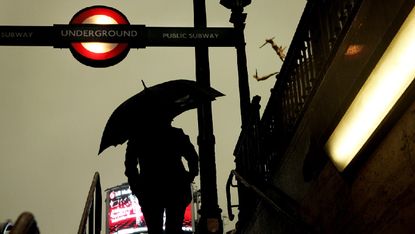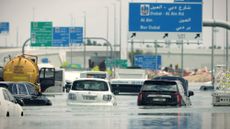Will London’s Tube stations face more floods?
An unpublished London Underground report identified 85 Tube stations as being at ‘high risk’ of flooding

Flash flooding swept parts of London on Sunday afternoon, leading to the closure of many major roads, the abandoning of vehicles and the submerging of several Tube stations.
The London Fire Brigade took more than 1,000 flooding-related calls and had to rescue people trapped in cars, as well as those with flooded basements and collapsed ceilings, says the BBC. Met Police officers were drafted in to support the firefighters.
Several London Underground stations, including Covent Garden, Edgware Road, Kennington and Stockwell, were forced to close, as well as east London’s Pudding Mill Lane DLR station, which was entirely submerged by rainwater. Videos shared on social media showed what the London Evening Standard described as “torrents of water” gushing into the station, creating “a whirlpool” at the ticket barriers.
Subscribe to The Week
Escape your echo chamber. Get the facts behind the news, plus analysis from multiple perspectives.

Sign up for The Week's Free Newsletters
From our morning news briefing to a weekly Good News Newsletter, get the best of The Week delivered directly to your inbox.
From our morning news briefing to a weekly Good News Newsletter, get the best of The Week delivered directly to your inbox.
By Monday morning, just one station – Stepney Green in east London – remained closed due to flooding, with other stations closed due to staff shortages. Although the weather was warmer and drier on Monday than Sunday, more torrential rain is expected in the capital during the rest of the week.
But as shocking as yesterday’s London Underground flooding was, the Tube system’s vulnerability to flash flooding should not have come as a surprise to Transport for London.
Back in 2016, The Independent accessed an unpublished London Underground flood risk report which was funded after Hurricane Sandy submerged parts of the New York metro system in 2012. The report identified 85 Tube stations as being at “high risk” of flooding, including the particularly busy terminals of King’s Cross, London Bridge and Waterloo.
Across the city, Finsbury Park, Notting Hill Gate, Seven Sisters, Colliers Wood, Stockwell and Marble Arch were all in the top ten highest-risk stations.
The report found that both climate change and the “increased laying of asphalt over earth surfaces”, which puts more pressure on sewers, would contribute to increase flooding in London and subsequently the city’s underground system in the future. “London has been fortunate to escape the worst of recent storm events in the UK, but it is only a matter of time before heavy rainfall seriously affects London and the underground network,” it added.
The Guardian, which also obtained a copy of the unpublished report, reported that the London Underground had requested £3m over the next three years “to analyse the riskiest sites in greater detail and to begin to install protective measures”. But the Tube’s head drainage engineer told the paper that the amount would not “scratch the surface” of the problem. Over the past few years, Transport for London, which oversees London Underground’s budget, has seen its funding repeatedly slashed.
In 2019, a report by Caroline Russell, a Green Party representative of the London Assembly, found that flooding had forced the closure of Tube stations for more than 137 hours since 2014. The Climate Change Risks for London report found that, on average, a station closed for more than two hours when shut by flooding and that 41 different stations had reported closures due to floods since 2015.
Fifteen months later, in January 2021, Russell warned London Mayor Sadiq Khan that he needed to accelerate the construction of Sustainable Drainage Systems (SuDS) or London could face a future of flooded Tube stations. SuDS avoid letting excess rain run off into conventional drains and sewers, which cannot deal with “the extreme weather expected in the coming years”, Russell said.
“The Mayor needs to show leadership and speed up the delivery of new SuDS schemes all over London to stop flooding closing our tube stations, blocking streets and putting the homes and businesses of Londoners at risk,” she added in a statement.
In December last year, the mayor said “London and other urban areas find it harder to attract government funding for surface water flood protection” as the many small schemes needed to manage the problem “rarely meet the funding criteria”.
He said City Hall was working with the Environment Agency and other key stakeholders to manage flood risk and unlock further funding.
Sunday’s flooding came just two weeks after flash flooding hit parts of London, with some neighbourhoods receiving a month’s worth of rain in a single day.
“The pictures of flooded stations and roads show the work that needs to be done to give people – not just in London but around the UK – the protection they need to try and help mitigate such events as and when they arise”, writes Chris Stevenson in The Independent.
Create an account with the same email registered to your subscription to unlock access.
Sign up for Today's Best Articles in your inbox
A free daily email with the biggest news stories of the day – and the best features from TheWeek.com
Kate Samuelson is the newsletter editor, global. She is also a regular guest on award-winning podcast The Week Unwrapped, where she often brings stories with a women’s rights angle. Kate’s career as a journalist began on the MailOnline graduate training scheme, which involved stints as a reporter at the South West News Service’s office in Cambridge and the Liverpool Echo. She moved from MailOnline to Time magazine’s satellite office in London, where she covered current affairs and culture for both the print mag and website. Before joining The Week, Kate worked as the senior stories and content gathering specialist at the global women’s charity ActionAid UK, where she led the planning and delivery of all content gathering trips, from Bangladesh to Brazil. She is passionate about women’s rights and using her skills as a journalist to highlight underrepresented communities.
Alongside her staff roles, Kate has written for various magazines and newspapers including Stylist, Metro.co.uk, The Guardian and the i news site. She is also the founder and editor of Cheapskate London, an award-winning weekly newsletter that curates the best free events with the aim of making the capital more accessible.
-
 Shardlake: a 'tightly plotted, gorgeously atmospheric piece of television'
Shardlake: a 'tightly plotted, gorgeously atmospheric piece of television'The Week Recommends Arthur Hughes captivates in this 'eminently watchable' Tudor murder mystery
By Irenie Forshaw, The Week UK Published
-
 Major League Baseball is facing an epidemic of pitcher's injuries
Major League Baseball is facing an epidemic of pitcher's injuriesUnder the Radar Many insiders are blaming the pitch clock for the rise in injuries — but the league is not so sure
By Justin Klawans, The Week US Published
-
 8 movie musicals that prove the screen can share the stage
8 movie musicals that prove the screen can share the stageThe Week Recommends The singing and dancing, bigger than life itself
By Scott Hocker, The Week US Published
-
 Costa Rica's renewable energy success could be under threat
Costa Rica's renewable energy success could be under threatUnder the radar Central American nation generates nearly all its electricity from renewable sources but climate change is bringing huge challenges
By Harriet Marsden, The Week UK Published
-
 What is cloud seeding and did it cause Dubai's severe rainfall?
What is cloud seeding and did it cause Dubai's severe rainfall?The Explainer The future is flooded
By Devika Rao, The Week US Published
-
 Ottawa climate talks: can global plastic problem be solved?
Ottawa climate talks: can global plastic problem be solved?In the spotlight Nations aim to draft world's first treaty on plastic pollution, but resistance from oil- and gas-producing countries could limit scope
By Harriet Marsden, The Week UK Published
-
 What is rock flour and how can it help to fight climate change?
What is rock flour and how can it help to fight climate change?The Explainer Glacier dust to the rescue
By Devika Rao, The Week US Published
-
 Arid Gulf states hit with year's worth of rain
Arid Gulf states hit with year's worth of rainSpeed Read The historic flooding in Dubai is tied to climate change
By Peter Weber, The Week US Published
-
 The growing thirst for camel milk
The growing thirst for camel milkUnder the radar Climate change and health-conscious consumers are pushing demand for nutrient-rich product – and the growth of industrialised farming
By Harriet Marsden, The Week UK Published
-
 Why curbing methane emissions is tricky in fight against climate change
Why curbing methane emissions is tricky in fight against climate changeThe Explainer Tackling the second most significant contributor to global warming could have an immediate impact
By Richard Windsor, The Week UK Published
-
 How the EU undermines its climate goals with animal farming subsidies
How the EU undermines its climate goals with animal farming subsidiesUnder the radar Bloc's agricultural policy incentivises carbon-intensive animal farming over growing crops, despite aims to be carbon-neutral
By Harriet Marsden, The Week UK Published